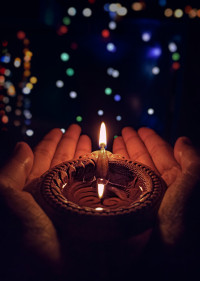As it is
Learning to touch yourself
Using menstrual cups can not only make menstrual experience cheaper and sustainable, but also normalise exploring one’s own reproductive system.
Shuvangi Khadka
Red blood droplets dripped a week early. The moment I had been postponing since last month finally dawned on me. The whole day, I thought about the little new package I hadn’t dared to open. The package containing my first menstrual cup that was supposed to go inside my vagina lay in one of the drawers of my wardrobe.
Last month, after reading a few articles and a few friends boasting about the menstrual cups, I had decided to jump on the menstrual cup bandwagon. Compared to sanitary pads and tampons, cups are said to make menstrual experience cheaper (in the long run), easier and sustainable.
Bidhi Mandal, who has been using the cup for a few months now says the first time was a lot of work both inserting and removing it. For her, there was no awkwardness, but slight pain.
The stigma attached to touching one’s genitals was what made me hesitate to use the cup as soon as it got delivered to my house. This was despite knowing that a menstrual cup’s size is no bigger than a penis or a sex toy.
The notion of touching yourself in the genitals and getting even deeper while using the cup can be daunting for a beginner. The cup champions speak in favour of “cupverting” because it is necessary to be comfortable getting our hands all up there. Not just for dealing with periods, but also understanding the mechanics of our bodies.
An individual can experiment with one’s body provided there is enough knowledge, confidence and space. Pratiksha Rajopdhyaya associates shame and fear as dominant feelings when she first decided to use the cups. These feelings were similar to when she started exploring herself sexually, personally and with a partner. She contributes this to the societal beliefs which teach females that their bodies are not their own but other people’s commodity and using cups actually made her feel like she was taking charge of her own body and sexuality.
Pratiksha is not the only one. Pooja Bista, who initiated the movement ‘Untold Period Stories’, used a cup for the first time three years after buying it. But when she finally came around to using it, she developed a hugging relationship with her vulva in those four days, she says.
In a similar vein, Sushmita Adhikari says cups helped her to feel more natural touching herself. And even for someone who has never wandered in the “forbidden” territory, the amount of research and discussion that one engages before actually using the cup, helps one understand how normal it is to let our fingers loose. Priyanjali Karn who bought the cup without knowing how it worked, made sure to do tons of research before taking the plunge. She watched videos that explained in detail where the cup fits in the reproductive area and for the first time felt her cervix to know the actual cup size she would be needing. She says that was the time she figured what’s down there, how things work and what goes where.
Nikita Tripathi bought a small size cup in 2019 and still struggles with 60 percent leakage. After watching more informational videos, she is now assured to measure her cervix and find a cup depending on the cervix’s length. On the face of prevailing societal sexual attitudes that look upon female sexuality as passive and vulnerable, use of a cup seems to be the start of these people taking agency of their bodies and desires.
This, however, is not limited to knowing about reproductive organs or menstruation, but also truly understanding your bodily reactions. Almost every menstrual cup user guides stress on the importance of breathing and relaxing. Priyanjali, despite all her research, almost had an anxiety attack trying to find the stem of the cup during its removal. It can be a really simple thing in general but while squatting half-naked in a bathroom through a state of panic, even telling yourself to keep calm and relax is an important life lesson one has to acquire.
Along with breathing, lubricants can be life savers. Pooja dedicates her transitional success to the use of lubricants. “I used lubricants on the outer side of the cup and my fingers a bit, and magically my vagina welcomed the cup. It almost felt like it was one thing I had been searching for the last three years but didn’t know what it was,” she exclaims.
A brand of menstrual cup talks about cups contributing to achieve better orgasms. The process of inserting and removing a cup actually stimulates and helps to improve pelvic floor muscles, which form grounds for solid orgasms. Flexible and stronger pelvic floor muscles ease up the vaginal penetration.
However, many menstruating individuals are sceptical about the use of menstrual cups because of the mere thought of having to insert it inside the vagina, and that it may not be suitable for virgins. An intact female hymen is epitome of purity and the insertion of a foreign object inside a vagina tears apart the conservative thoughts. When I elaborated on the use of a menstrual cup to my mother, her expression could only be described as “mortified”. In a recent conversation with some friends, I realised my mother was not the only parent sceptical about such “unnecessary” insertion.
The sheer volume of misconceptions that we have regarding our genitals makes us wonder if it can affect our virginity. But are we asking the right questions? Dr Kenusha Tiwari, Obstetrician and Gynecologist at Kathmandu Model Hospital and a longtime cup user says, “It is a misconception to think that use of menstrual cups makes one’s vagina lax. As it comes in different sizes, it can be easily used by virgins and those who have given birth vaginally multiple times.”
As an adult when you consume most of the information catered around normalising and celebrating male sexuality and male fantasies, trying to take charge of your own sexual needs much unlearning.
Access to sanitary pads is not the sole criterion for effective menstrual health management. In different developing countries, young girls are being provided with menstrual cups. In 2017, The Ruby Cup demonstrated a whopping 92 percent acceptance rate among girls in rural schools who were provided menstrual cups under The Rato Baltin project. In a pilot study done in rural Nepal, where menstrual cups were given to young participants, a number of them were found to be continuing their use after the study.
Using menstrual cups only makes it easier for menstruating individuals to know a life-long easy and sustainable technique of menstrual health management but also to understand their anatomy from a young age.
But it takes time getting used to menstrual cups. It took Bidhi two-three menstrual cycles to be okay with the existence of something foreign inside her body.
In Reddit, a boy wonders out loud if girls get turned on while putting in and putting out a tampon or a cup. I mean, I wish it was that easy. But when for the third time in a day I try to find the stem of my menstrual cup, all I can think of is the burning muscles, my fingertips twisting whatever it can grasp. In the aftermath I guess I do get turned on by how liberating it is once I have inserted it, by how I have enough experience to use a sex toy, by how I know where something goes and comes out of my vagina.
The first evening, after taking a deep breath, I pushed the cup inside me. I felt the walls of vagina caving in. I couldn’t see but fully imagine the suction created inside. And just like that I knew exactly how there are two different openings for pee and blood.




 9.12°C Kathmandu
9.12°C Kathmandu










